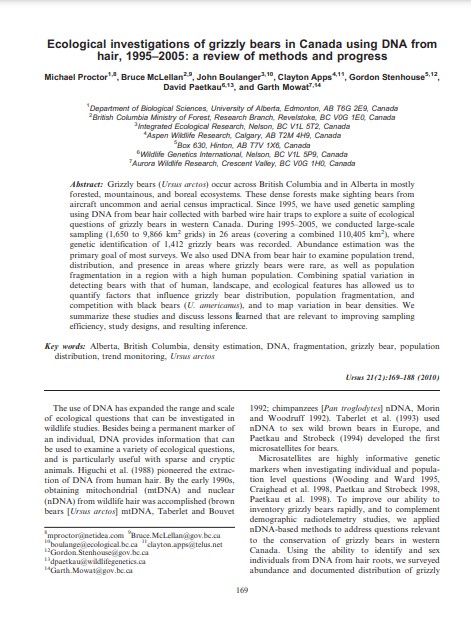Ecological investigations of grizzly bears in Canada using DNA from hair, 1995-2005: A review of methods and progress
Bosque Modelo:
Foothills
Temática:
Gestión forestal
Tipo de documento:
Artículo científico
Resumen
Grizzly bears (Ursus arctos) occur across British Columbia and in Alberta in mostly forested, mountainous, and boreal ecosystems. These dense forests make sighting bears from aircraft uncommon and aerial census impractical. Since 1995, we have used genetic sampling using DNA from bear hair collected with barbed wire hair traps to explore a suite of ecological questions of grizzly bears in western Canada. During 1995–2005, we conducted large-scale sampling (1,650 to 9,866 km2 grids) in 26 areas (covering a combined 110,405 km2 ), where genetic identification of 1,412 grizzly bears was recorded. Abundance estimation was the primary goal of most surveys. We also used DNA from bear hair to examine population trend, distribution, and presence in areas where grizzly bears were rare, as well as population fragmentation in a region with a high human population. Combining spatial variation in detecting bears with that of human, landscape, and ecological features has allowed us to quantify factors that influence grizzly bear distribution, population fragmentation, and competition with black bears (U. americanus), and to map variation in bear densities. We summarize these studies and discuss lessons learned that are relevant to improving sampling efficiency, study designs, and resulting inference.
Información Bibliográfica
Autor:
Proctor, M., McLellan, B., Boulanger, J., Apps, C., Stenhouse, G., Paetkau, D., & Mowat, G.
Revista:
Ursus
Año:
2010
N°:
2
País :
Canadá
Páginas:
169 -188
Volumen:
21
Idioma:
Ingles
Palabras claves
Alberta, British Columbia, density estimation, DNA, fragmentation, grizzly bear, population distribution, trend monitoring, Ursus arctos





